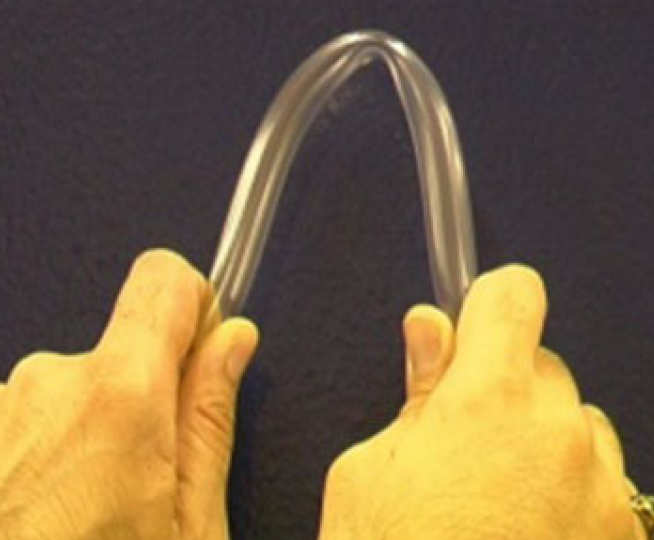Localized buckling in tubes under bending
Research Team
- Dr Khurram Wadee: University of Exeter
- Professor Ahmer Wadee: Imperial College London
- Professor Andrew Bassom: University of Western Australia
- Dr Nigel Kaye: Clemson University, USA
- Dr Andreas Aigner: University of Exeter
Background

Why does a hose pipe kink when it is bent? What causes a tube with a circular cross-section to lose this quality under a uniform bending stress? Well, under normal circumstances when deflections are small and so-called engineer's bending theory is assumed, the answers to these questions are difficult to address. However, if deflections are moderately large and shearing strains are allowed to develop through the depth of the tube, the problem becomes tractable and the questions above can be answered to some extent.
It was an alumnus of this department in the 1920s, L. G. Brazier, who was the first to devise a theory for the distortion in the cross-section in a bent thin-walled tube. He realized that the flexure distorted the tube cross-section and ovalized it. However, this ovalization was assumed to be uniform and even though this worked reasonably for small curvatures, as soon as these became large the theory could not cope, and certainly could not account for deformation localization as shown above.
This research was initiated in a collaboration with Dr Khurram Wadee, who is in the Computational Engineering Group in the School of Engineering, Computer Science and Mathematics at the University of Exeter.
Methodology and Demonstration
The new mechanical model has been developed based on classical work by Reissner in the early 1960s. A variational model was formulated using a Timoshenko beam approach (in a similar way to more recent work on compression sandwich structures) and by including cross-section distortion, a system of coupled nonlinear differential equations were derived. The numerical solution to these equations involves using AUTO.
Download an MPEG (17.7Mb) of the demonstration of bending of a plastic tube (that is a polymer-based material not a material undergoing permanent deformation!).
Seminars and Conference Presentations
- June 2008
Gold Coast, Queensland, Australia. Fifth International Conference on Thin-Walled Structures (ICTWS 2008). Conference presentation delivered by Stylianos Yiatros. - March 2008
Keele University. Research Seminar - September 2007
Cape Town, South Africa. Third International Conference on Structural Engineering,
Mechanics and Computation (SEMC 2007). - September 2005
Department of Civil and Environmental Engineering, Imperial College London. Research Seminar.
Articles
-
Wadee, M. K., Wadee, M. A., Bassom, A. P. and Aigner, A. A., 2006. Longitudinally inhomogeneous deformation patterns in isotropic tubes under pure bending. Proc. R. Soc. A, 462 (2067):817-838.
-
Wadee, M. K., Wadee, M. A. and Bassom, A. P., 2007. Effects of orthotropy and variation of Poisson's ratio on the behaviour of tubes in pure flexure. J. Mech. Phys. Solids, 55 (5):1086-1102.
-
Wadee, M. A., Wadee, M. K. and Bassom, A. P., 2006. Analytical modelling of non-uniform deformation in thin-walled orthotropic tubes under pure bending. In J. A. Packer and S. Willibald, editors, Tubular structures XI: Proceedings of the 11th international symposium and IIW international conference on tubular structures, pp. 195-202, Quebec City, Canada.
-
Wadee, M. A. and Kaye, N. B., 2007. Buckling of thin-walled tubes under combined bending and pressure loading. In A. Zingoni, editor, Recent developments in structural engineering, mechanics and computation, pp. 339-340. Conference held in Cape Town, South Africa.
- Yiatros, S. and Wadee, M. A. 2008. Advances in the analytical modelling of thin-walled tubes in pure flexure. In Mahendran, M., editor, Thin-walled structures: Recent innovations and developments, volume 2, pages 1017–1024, Brisbane, Australia, 2008. Queensland University of Technology.


